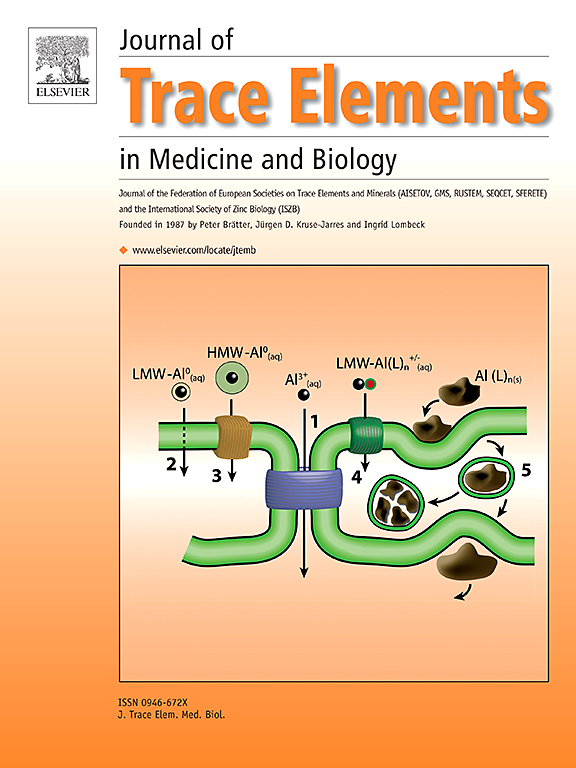Metal and metalloid contamination, oxidative stress and genotoxicity in Nile Tilapia (Oreochromis niloticus) from an important eutrophicated lagoon in southeastern Brazil
IF 3.6
3区 医学
Q2 BIOCHEMISTRY & MOLECULAR BIOLOGY
Journal of Trace Elements in Medicine and Biology
Pub Date : 2025-07-19
DOI:10.1016/j.jtemb.2025.127697
引用次数: 0
Abstract
Coastal lagoons are highly susceptible to chemical contamination, due to their proximity to urban and industrial areas. This seasonal cross-sectional study based on primary data collection investigated the effects of metal and metalloid exposure on Nile tilapia (Oreochromis niloticus) from Jacarepaguá Lagoon (LJPA), a eutrophicated and urbanized coastal ecosystem in southeastern Brazil. Fish (n = 44) were sampled over one year, covering all four seasons at five fixed locations distributed across the lagoon, concurrently with surface water collection. Metal and metalloid concentrations in liver and muscle tissues were quantified by inductively coupled plasma mass spectrometry (ICP-MS). Analyzed biomarkers included MT, SOD, GST, GSH, LPO, and DNA damage (comet assay). Poor physicochemical and microbiological water quality according to Brazilian legislation were observed. Sampling during the spring and summer revealed greater metal diversity in tissues, likely influenced by increased rainfall and runoff. Arsenic, Cd, Hg and Pb were detected in both muscle and liver. Superoxide-dismutase activity decreased by 38–66.5 % in liver and 35–78 % in muscle, while GST activity in muscle decreased by 67.1–73.5 %. Muscle MT levels increased by 39–280 % across seasons, with peak liver MT values observed during spring (C4). Hepatic CARB increased by 119–662 %, especially in summer (C5), and the highest liver LPO levels were recorded in autumn (p < 0.05). Significant correlations between metal concentrations and biomarkers included negative associations between Ti and LPO (ρ = –0.93) and MT (ρ = –0.85), and between Hg and GSH (ρ = –0.90). Muscle LPO was negatively associated with Ni (ρ = –0.72), while GSH showed positive correlations with Cd, Ni, Ti and Fe. DNA damage was significantly higher in individuals collected during the summer (C5), when several metals were detected, suggesting genotoxic effects likely driven by seasonal factors. A Principal Component Analysis revealed distinct seasonal patterns of both metal bioaccumulation and physiological stress, with greater separation among muscle samples and stronger associations with oxidative biomarkers in liver. These findings highlight the need for environmental monitoring and management strategies to mitigate the impacts of metal pollution on aquatic life in urban coastal lagoons.
巴西东南部一个重要的富营养化泻湖尼罗罗非鱼的金属和类金属污染、氧化应激和遗传毒性
由于靠近城市和工业区,沿海泻湖极易受到化学污染。这项基于原始数据收集的季节性横断面研究调查了金属和类金属暴露对巴西东南部富营养化和城市化沿海生态系统jacarepagu泻湖(LJPA)尼罗罗非鱼(Oreochromis niloticus)的影响。鱼类(n = 44)在一年多的时间内取样,覆盖整个泻湖分布的五个固定地点的所有四个季节,同时收集地表水。采用电感耦合等离子体质谱法(ICP-MS)测定肝脏和肌肉组织中金属和类金属浓度。分析的生物标志物包括MT、SOD、GST、GSH、LPO和DNA损伤(彗星测定)。根据巴西立法,观察到物理化学和微生物水质较差。春季和夏季的采样显示,组织中的金属多样性更大,可能受到降雨和径流增加的影响。肌肉和肝脏中均检测到砷、镉、汞和铅。肝脏超氧化物歧化酶活性降低38 ~ 66.5 %,肌肉超氧化物歧化酶活性降低35 ~ 78 %,肌肉GST活性降低67.1 ~ 73.5 %。肌肉MT水平在不同季节增加了39 - 280 %,肝脏MT值在春季达到峰值(C4)。肝脏CARB增加了119-662 %,特别是在夏季(C5),肝脏LPO水平在秋季最高(p <; 0.05)。金属浓度与生物标志物之间的显著相关性包括Ti与LPO (ρ = -0.93)和MT (ρ = -0.85)以及Hg与GSH (ρ = -0.90)之间的负相关。肌肉LPO与Ni呈负相关(ρ = -0.72), GSH与Cd、Ni、Ti、Fe呈正相关。在夏季收集的个体中,DNA损伤明显更高(C5),当时检测到几种金属,表明可能由季节因素驱动的基因毒性作用。主成分分析揭示了金属生物积累和生理应激的明显季节性模式,肌肉样本之间的分离程度更高,与肝脏中氧化生物标志物的关联更强。这些研究结果强调了环境监测和管理策略的必要性,以减轻金属污染对城市沿海泻湖水生生物的影响。
本文章由计算机程序翻译,如有差异,请以英文原文为准。
求助全文
约1分钟内获得全文
求助全文
来源期刊
CiteScore
6.60
自引率
2.90%
发文量
202
审稿时长
85 days
期刊介绍:
The journal provides the reader with a thorough description of theoretical and applied aspects of trace elements in medicine and biology and is devoted to the advancement of scientific knowledge about trace elements and trace element species. Trace elements play essential roles in the maintenance of physiological processes. During the last decades there has been a great deal of scientific investigation about the function and binding of trace elements. The Journal of Trace Elements in Medicine and Biology focuses on the description and dissemination of scientific results concerning the role of trace elements with respect to their mode of action in health and disease and nutritional importance. Progress in the knowledge of the biological role of trace elements depends, however, on advances in trace elements chemistry. Thus the Journal of Trace Elements in Medicine and Biology will include only those papers that base their results on proven analytical methods.
Also, we only publish those articles in which the quality assurance regarding the execution of experiments and achievement of results is guaranteed.

 求助内容:
求助内容: 应助结果提醒方式:
应助结果提醒方式:


